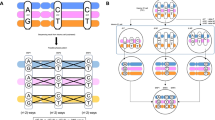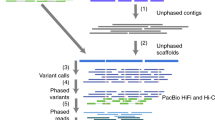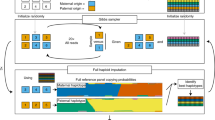Abstract
We report a method for multilocus long-range haplotyping on human chromosome molecules in vitro based on the DNA polymerase colony (polony) technology. By immobilizing thousands of intact chromosome molecules within a polyacrylamide gel on a microscope slide and performing multiple amplifications from single molecules, we determined long-range haplotypes spanning a 153-Mb region of human chromosome 7 and found evidence of rare mitotic recombination events in human lymphocytes. Furthermore, the parallel nature of DNA polony technology allows efficient haplotyping on pooled DNAs from a population on one slide, with a throughput three orders of magnitudes higher than current molecular haplotyping methods. Linkage disequilibrium statistics established by our pooled DNA haplotyping method are more accurate than statistically inferred haplotypes. This haplotyping method is well suited for candidate gene–based association studies as well as for investigating the pattern of recombination in mammalian cells.
This is a preview of subscription content, access via your institution
Access options
Subscribe to this journal
Receive 12 print issues and online access
$209.00 per year
only $17.42 per issue
Buy this article
- Purchase on Springer Link
- Instant access to full article PDF
Prices may be subject to local taxes which are calculated during checkout


Similar content being viewed by others
References
Michalatos-Beloin, S., Tishkoff, S.A., Bentley, K.L., Kidd, K.K. & Ruano, G. Molecular haplotyping of genetic markers 10 kb apart by allele-specific long-range PCR. Nucleic Acids Res. 24, 4841–4843 (1996).
Ding, C. & Cantor, C.R. Direct molecular haplotyping of long-range genomic DNA with M1-PCR. Proc. Natl. Acad. Sci. USA 100, 7449–7453 (2003).
Mitra, R.D. et al. Digital genotyping and haplotyping with polymerase colonies. Proc. Natl. Acad. Sci. USA 100, 5926–5931 (2003).
Woolley, A.T., Guillemette, C., Li Cheung, C., Housman, D.E. & Lieber, C.M. Direct haplotyping of kilobase-size DNA using carbon nanotube probes. Nat. Biotechnol. 18, 760–763 (2000).
Douglas, J.A., Boehnke, M., Gillanders, E., Trent, J.M. & Gruber, S.B. Experimentally-derived haplotypes substantially increase the efficiency of linkage disequilibrium studies. Nat. Genet. 28, 361–364 (2001).
Patil, N. et al. Blocks of limited haplotype diversity revealed by high-resolution scanning of human chromosome 21. Science 294, 1719–1723 (2001).
Mitra, R.D. & Church, G.M. In situ localized amplification and contact replication of many individual DNA molecules. Nucleic Acids Res. 27, e34 (1999).
Zhu, J., Shendure, J., Mitra, R.D. & Church, G.M. Single molecule profiling of alternative pre-mRNA splicing. Science 301, 836–838 (2003).
Mitra, R.D., Shendure, J., Olejnik, J., Edyta Krzymanska, O. & Church, G.M. Fluorescent in situ sequencing on polymerase colonies. Anal. Biochem. 320, 55–65 (2003).
SantaLucia, J., Jr. & Hicks, D. The thermodynamics of DNA structural motifs. Annu. Rev. Biophys. Biomol. Struct. 33, 415–440 (2004).
Stephens, M., Smith, N.J. & Donnelly, P. A new statistical method for haplotype reconstruction from population data. Am. J. Hum. Genet. 68, 978–989 (2001).
Tishkoff, S.A., Pakstis, A.J., Ruano, G. & Kidd, K.K. The accuracy of statistical methods for estimation of haplotype frequencies: an example from the CD4 locus. Am. J. Hum. Genet. 67, 518–522 (2000).
Cohen, J.C. et al. Multiple rare alleles contribute to low plasma levels of HDL cholesterol. Science 305, 869–872 (2004).
Wang, N., Akey, J.M., Zhang, K., Chakraborty, R. & Jin, L. Distribution of recombination crossovers and the origin of haplotype blocks: the interplay of population history, recombination, and mutation. Am. J. Hum. Genet. 71, 1227–1234 (2002).
Forton, J. et al. Accuracy of haplotype reconstruction from haplotype-tagging single-nucleotide polymorphisms. Am. J. Hum. Genet. 76, 438–448 (2005).
Patterson, N. et al. Methods for high-density admixture mapping of disease genes. Am. J. Hum. Genet. 74, 979–1000 (2004).
Smith, M.W. et al. A high-density admixture map for disease gene discovery in african americans. Am. J. Hum. Genet. 74, 1001–1013 (2004).
Bersaglieri, T. et al. Genetic signatures of strong recent positive selection at the lactase gene. Am. J. Hum. Genet. 74, 1111–1120 (2004).
Prado, F., Cortes-Ledesma, F., Huertas, P. & Aguilera, A. Mitotic recombination in Saccharomyces cerevisiae. Curr. Genet. 42, 185–198 (2003).
Hendricks, C.A. et al. Spontaneous mitotic homologous recombination at an enhanced yellow fluorescent protein (EYFP) cDNA direct repeat in transgenic mice. Proc. Natl. Acad. Sci. USA 100, 6325–6330 (2003).
Meyn, M.S. High spontaneous intrachromosomal recombination rates in ataxia-telangiectasia. Science 260, 1327–1330 (1993).
Kehrer-Sawatzki, H. et al. High frequency of mosaicism among patients with neurofibromatosis type 1 (NF1) with microdeletions caused by somatic recombination of the JJAZ1 gene. Am. J. Hum. Genet. 75, 410–423 (2004).
Winckler, W. et al. Comparison of fine-scale recombination rates in humans and chimpanzees. Science 308, 107–111 (2005).
Jeffreys, A.J., Neumann, R., Panayi, M., Myers, S. & Donnelly, P. Human recombination hot spots hidden in regions of strong marker association. Nat. Genet. 37, 601–606 (2005).
Kauppi, L., Jeffreys, A.J. & Keeney, S. Where the crossovers are: recombination distributions in mammals. Nat. Rev. Genet. 5, 413–424 (2004).
von Ahsen, N., Wittwer, C.T. & Schutz, E. Oligonucleotide melting temperatures under PCR conditions: nearest-neighbor corrections for Mg(2+), deoxynucleotide triphosphate, and dimethyl sulfoxide concentrations with comparison to alternative empirical formulas. Clin. Chem. 47, 1956–1961 (2001).
Cram, L.S., Bell, C.S. & Fawcett, J.J. Chromosome sorting and genomics. Methods Cell Sci. 24, 27–35 (2002).
Acknowledgements
We thank N. Reppas, F. Isaacs, J. Akey and L. Jin for critical review of the manuscript, C. Varma for assistance in polony image analyses. This work was supported by the US National Human Genome Research Institute-Center of Excellence in Genome Science grants.
Author information
Authors and Affiliations
Corresponding author
Ethics declarations
Competing interests
The authors declare no competing financial interests.
Supplementary information
Supplementary Fig. 1
Multi-locus polony haplotyping on CD36 and NOS3. (PDF 134 kb)
Supplementary Fig. 2
Effects of sample size on LD patterns revealed by pooled polony haplotyping. (PDF 164 kb)
Supplementary Table 1
Summary statistics of polony haplotyping on pooled DNA of 24 African Americans. (PDF 50 kb)
Supplementary Table 2
CD36 haplotypes determined by polony haplotyping. (PDF 31 kb)
Supplementary Table 3
Comparison of LD statistics in NOS3 determined by four methods. (PDF 54 kb)
Rights and permissions
About this article
Cite this article
Zhang, K., Zhu, J., Shendure, J. et al. Long-range polony haplotyping of individual human chromosome molecules. Nat Genet 38, 382–387 (2006). https://doi.org/10.1038/ng1741
Received:
Accepted:
Published:
Issue Date:
DOI: https://doi.org/10.1038/ng1741
This article is cited by
-
Noninvasive prenatal testing of α-thalassemia and β-thalassemia through population-based parental haplotyping
Genome Medicine (2021)
-
Inverse PCR to perform long-distance haplotyping: main applications to improve preimplantation genetic diagnosis in hemophilia
European Journal of Human Genetics (2019)
-
DNA origami-based shape IDs for single-molecule nanomechanical genotyping
Nature Communications (2017)
-
Quantifying RNA allelic ratios by microfluidic multiplex PCR and sequencing
Nature Methods (2014)
-
Whole-genome molecular haplotyping of single cells
Nature Biotechnology (2011)



